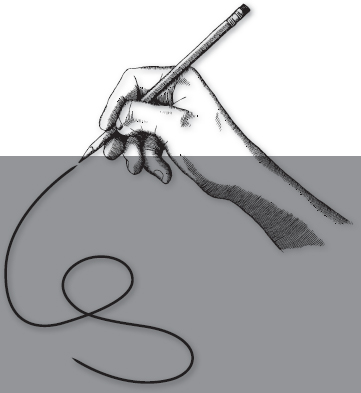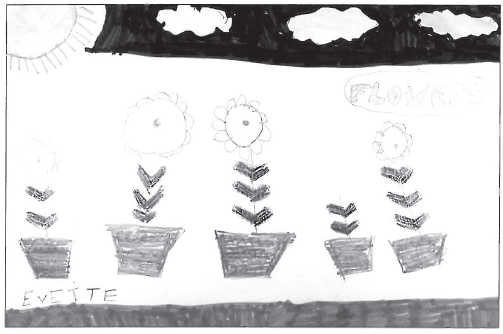
When we were very young children, we were encouraged to draw and color pictures, but the first time we held a pencil or crayon in our hands it felt awkward and rather strange. With continued use we became more adept, but it was only when we arrived at nursery or elementary school that we were taught how to draw a picture and then sign our names at the bottom of it, usually in capital letters.
Today, our children are encouraged to develop hand-eye coordination, and most of them are able to read and write their own names by the time they reach elementary school. Writing is taught in elementary schools, with children first being taught to form letters of the alphabet, and later being taught cursive. We all have memories of the triple-lined paper we were given so we could practice staying on the line, and make sure our letter forms reached above or below the center dashed line as instructed.

A child's drawing, signed
As the years go by, a child's unique expression of writing develops. Over time, and with the encouragement of their teachers, a child's writing becomes more practiced. Most children are taught to write in a similar way, but by the time they reach the age of about twelve years, they choose to vary their writing style in accordance with their unique personalities. From that time on, their signatures become expressions of who they are.
The study of handwriting is referred to as graphology. Handwriting can also be regarded as “brain writing.” It is an expressive action that reveals the whole personality; each mark on the page contains meanings that a graphologist can interpret. By the time adulthood arrives, all our experiences—the untold twists and turns, ups and downs, highs and lows of life—are reflected in our handwriting. The overall presence of a writing sample on a plain piece of paper can denote a person's unique and individual expression of the inner self. However, while there are many traits we can identify through handwriting analysis, and many ways to identify those traits, keep in mind that it is not possible to identify the gender of an individual from a handwriting sample, or to use graphology to predict the future.
Before you begin to explore this stimulating subject, it would be helpful to collect several handwriting samples from friends and family. Just a few words positioned on a piece of paper, greeting card, or envelope will portray a lot about the writer of those words. Collect as many as possible, and with some practice you will be amazed by what can be revealed.
Different writing characteristics are called “handwriting indicators” or “writing traits.” The many script samples in this book include examples of size, slant, pressure, baseline, connection of letters and words, margins on the page and envelope, the three zones, and the signature.
Nowadays, many companies use graphology as an unbiased tool to determine a job applicant's suitability, making handwriting analysis an effective, profitable, and legal means of screening employees. To many, graphology is on par with fortune telling, but some of the largest corporations take it seriously enough to request that job applicants apply in their own handwriting.
Throughout the ages, humanity's method of communication has been primarily in the form of the written word-letters, notes, postcards, lists, reminders, and maybe even a daily diary. Nowadays, however, we rely heavily on technology-computers, cell phones, and so on-to communicate instantly with one another. This is particularly obvious among the members of the younger generation, who, it seems, rarely put pen to paper.
Our handwriting is the product of mind and body because it is composed of thoughts expressed on paper, with the physical movements controlled by the brain but using the muscles of the arm and hand. These movements are influenced by our feelings—our moods, emotions, and reactions to whatever is going on in our lives at that time. Whether we are depressed or worried, have feelings of optimism, anger, or elation, they all have a bearing on the way we write. Our innermost personality is shown on the page at the time of writing.
Whereas a person's handwriting represents the way he or she feels inside, a person's signature represents the public image that the writer wants to project. A wide variation between a person's writing and his or her signature indicates a big difference between the private and public selves. When the writing and the signature are identical, then “what you see is what you get.”
An ideal writing sample should be written spontaneously, in ink, on unlined paper, and should be signed by the writer. A sentence or two with a signature, or sometimes a signature alone, can be sufficient for the purposes of analysis if there are enough letters within the sample. A considerable amount of handwriting analysis is common sense. For instance, people who dot their i's and cross their t's precisely tend to be more meticulous than those who do not. Stylish people often have very stylish writing, and so on. Much of what you learn in handwriting analysis will not surprise you at all. The more you learn about graphology, the more you will learn about your friends and family.